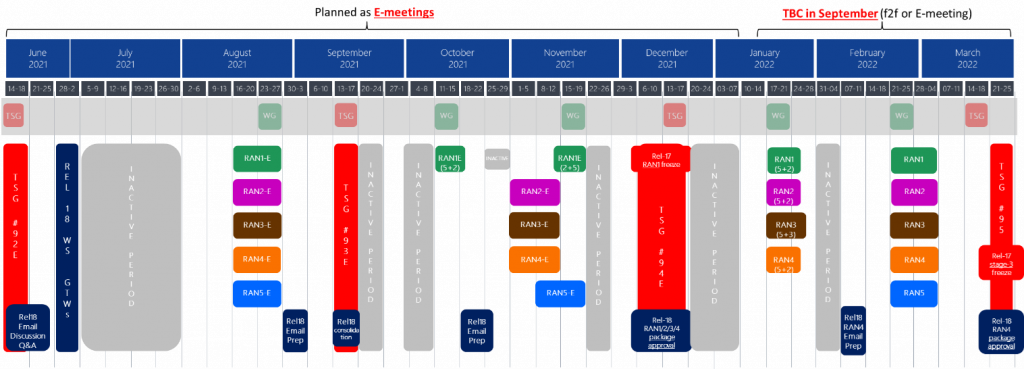12
Jul
5G Future taking shape with Rel. 17, 18, and 5G Advanced

The twin events of 3GPP RAN Plenary #92e and Rel. 18 workshops are starting to shape the future of 5G. The plenary substantially advanced Rel.17 development and the workshop kick-started the Rel 18 work. Amidst these two, 3GPP also approved the “5G Advanced” as the marketing name for releases 18 and beyond. Being a 3GPP member, I had the front row seats to witness all the interesting discussions and decisions.
With close to 200 global operators already live with the first phase of 5G, and almost every cellular operator either planning, trialing, or deploying their first 5G networks, the stage is set for the industry to focus on the next phase of 5G.
Solid progress on Rel. 17, projects mostly on track
The RAN Plenary #92-e was yet another virtual meeting, where the discussions were through a mix of emails and WebEx conference sessions. It was also the first official meeting for the newly elected TSG RAN chair Dr. Wanshi Chen of Qualcomm, and three vice-chairs, Hu Nan of China Mobile, Ronald Borsato of AT&T, and Axel Klatt of Deutsche Telekom.
Most of the plenary time was spent on discussing various aspects of Rel. 17, which has a long list of features and enhancements. For easy reference and better understanding, I divide them (not 3GPP) into three major categories as below:
New concepts:
Enhancements for better eXtended Reality (XR), mmWave support up to 71 GHz, new connection types such as NR – Reduced Capability (RedCap, aka NR-Light), NR & NB-IoT/eMTC, and Non-Terrestrial Network (NTN).
Improving Rel.16 features
Enhanced Integrated Access & Backhauls (IAB), improved precise positioning and Sidelink support, enhanced IIoT and URLLC functionality including unlicensed spectrum support, and others.
Fine-tuning Rel. 15 features
Further enhanced MIMO (FeMIMO), Multi-Radio Dual Connectivity (MRDC), Dynamic Spectrum Sharing (DSS) enhancements, Coverage Extension, Multi-SIM, RAN Slicing, Self-Organizing Networks (SON), QoE Enhancements, NR-Multicast/Broadcast, UE power saving, and others.
For details on these features please refer to my article series “The Chronicles of 3GPP Rel. 17.”
There was a lot of good progress made on many of these features in the plenary. All the leads reaffirmed the timeline agreed upon in the previous plenary. It was also decided that all the meetings in 2021 will be virtual. The face-to-face meetings will hopefully start in 2022.
3GPP RAN TSG meeting schedule (Source: 3gpp.org)
Owing to the workload and the difficulties of virtual meetings, the possibility of down-scoping of some features was also discussed. These include some aspects of FeMIMO and IIoT/URLLC. Many delegates agreed that it is better to focus on a robust definition of only certain parts of the features rather than diluted full specifications. The impact of this down-scoping on the performance is not fully known at this point. The discussion is ongoing, and a final decision will be taken during the next RAN plenary #93e in September 2021.
The dawn of 5G Advanced
The releases 18 and beyond were officially christened as 5G Advanced in May 2021, by 3GPP’s governing body Project Coordination Group (PCG). This is in line with the tradition set by HSPA and LTE, where the evolutionary steps were given “Advanced” suffixes. 5G Advanced naming was an important and necessary decision to demarcate the steps in the evolution and to manage the over-enthusiastic marketing folks jumping early to 6G.
The 5G Advanced standardization process was kickstarted at the 3GPP virtual workshop held between Jun 28th and July 2nd, 2021. The workshop attracted a lot of attention, with more than 500 submissions from more than 80 companies, and more than 1200 delegates attending the event.
The submissions were initially divided into three groups. According to the TSG RAN chair, Dr. Wanshi the submissions were distributed almost equally among the groups:
-
eMBB (evolved Mobile BroadBand)
-
Non-eMBB evolution
-
Cross-functionalities for both eMBB and non-eMBB driven evolution.

